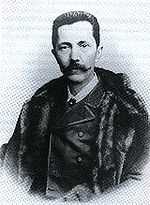Giulio Bizzozero
| Giulio Bizzozero | |
|---|---|
|
Giulio Bizzozero | |
| Born |
20 March 1846 Varese, Italy |
| Died | 8 April 1901 |
| Citizenship | Italian |
| Alma mater | University of Pavia, University of Turin, |
| Known for | Helicobacter pylori, histography, platelet |
Giulio Bizzozero (Italian pronunciation: [ˈdʒuljo bidˈdzɔddzero]; 20 March 1846 – 8 April 1901) was an Italian doctor and medical researcher.
Background
Bizzozero was born in Varese, Lombardy. He studied medicine at the University of Pavia, where he performed histological and histopathological research under the guidance of Paolo Mantegazza (1831-1910). In 1866 he graduated from Pavia at the age of 20. In 1867, he was chosen as the chief of general pathology and histology at the University of Pavia. This institute trained many important Italian researchers, such as Camillo Golgi (1843-1926).
In 1872, at the age of 26, he moved to the University of Turin, and founded the Institute of General Pathology. While at Turin he worked to improve hygiene and water supply. Among the physicians who worked and studied in his laboratory at Turin were Edoardo Bassini (1844-1924) and Carlo Forlanini (1847-1918).[1]
In April 1901, he died of pneumonia. For his scientific achievements, Bizzozero was named by king Humbert I, a life senator in 1890.
Achievements
He was one of the pioneers of histography, and, more generally, the use of the microscope in medical research. He is known for his early description of Helicobacter pylori (1892), the bacteria that is responsible for peptic ulcer disease (although this fact was not generally accepted until the 1990s).[2]
He is credited with the discovery of the function of platelets in the coagulation of blood. In the early 1880s he described platelet functionality in blood flow conditions and the relationship between platelet adhesion, aggregation and subsequent formation and deposition of fibrin.[3]
Other significant work by Bizzozero included research of haematopoiesis in the bone marrow, studies involving phagocytosis in the eye, and the identification of desmosomes (nodes of Bizzozero), structures that he first discovered in the stratum spinosum of epidermis.[4][5]
See also
References
- Figura, Natale; Laura Bianciardi (2002). "Helicobacters were discovered in Italy in 1892: An episode in the scientific life of an eclectic pathologist, Giulio Bizzozero". In Barry Marshall. Helicobacter Pioneers: Firsthand Accounts from the Scientists Who Discovered Helicobacters. Victoria, Australia: Blackwell Science Asia. pp. 1–13. ISBN 0-86793-035-7.
- Vigliani, R. (August 2002). "Giulio Bizzozero: Remenbrance 100 years after his death". Pathologica 94 (4): 206–215. doi:10.1007/s102420200033. PMID 12325420.
- Brewer DB. Max Schultze (1865), G. Bizzozero (1882) and the discovery of the platelet. Br J Haematol 2006;133:251-8. PMID 16643426.
From Italian Senate website] (a brief biography)
- ↑ Bizzozero, Giulio - Universalium (biographical information)
- ↑ Helicobacter pylori and the Bacterial Theory of Ulcers by Debra Ann Meuler Department of Natural Sciences Cardinal Stritch University
- ↑ NCBI Giulio Bizzozero and the discovery of platelets.
- ↑ Giulio Bizzozero: a pioneer of cell biology by Paolo Mazzarello, Alessandro L. Calligaro and Alberto Calligaro
- ↑ NCBI Journal List >Cold Spring Harb Perspect Biol >v.1(2); Aug 2009 >PMC2742091, The Desmosome
|
